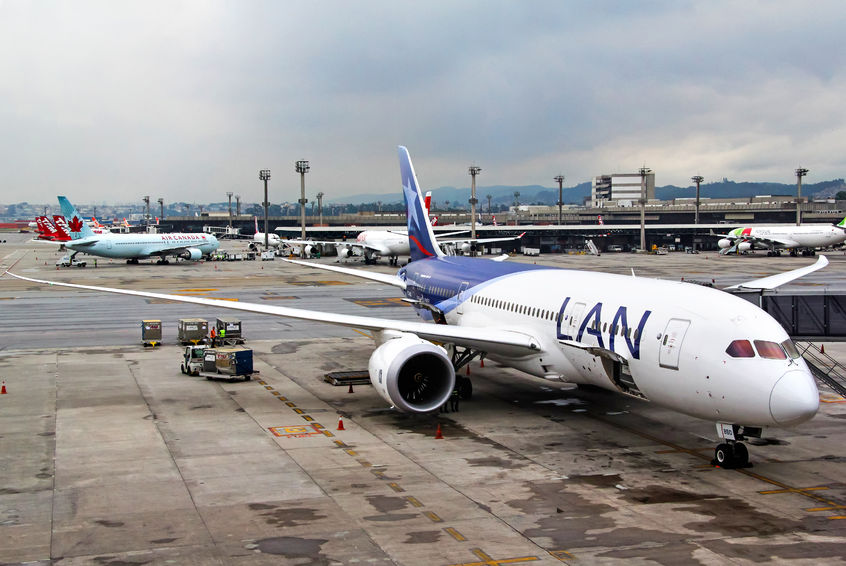After the close of markets on Thursday Delta announced they’re acquiring 20% of LATAM. That’s huge for Delta giving them a big presence in Latin America, on top of owning 49% of Aeromexico.
This positions Delta well to grow in American’s back yard of Miami as well given the large market there for South America. And it undercuts American’s South America flights by denying them connecting feed, and blocks American’s joint venture with LATAM (which would have had to exclude Chile flights).
Delta held a call with investors this morning and shared that they will,
- Begin codesharing potentially by the end of the year
- Invest $350 million over several years to support the strategic partnership, which means LATAM’s departure from oneworld and integration with Delta
- Take on 14 Airbus A350s from LATAM, 4 that are currently operating and 10 orders [2 aircraft will come in late 2020, with the remaining by 2025]
- Pay $16 per share in a public tender offer which is a significant premium to market and receive representation on LATAM board of directors
- Drop their Gol partnership
- Finance nearly all of the cost via new debt
They expect a 12-24 month transition to fully realize the partnership. Delta doesn’t anticipate growing its LATAM stake beyond 20%.

Copyright: artzzz / 123RF Stock Photo
How This Fits Into Delta’s Strategy
Delta is shifting away from an alliance focus and “taking a different approach” where they use local airline brands that can operate in local markets around the world and influence those airlines to be more efficient.
The Atlanta-based carrier owns 49% of Virgin Atlantic and Aeromexico and stakes in Air France KLM, Korean Air, and China Eastern (as well as a 9% stake in Gol they’ll be divesting).
There are limited opportunities for growth in the U.S. However they can grow their business around the world by taking stakes in and partnering closely with airlines around the world. In most cases they cannot outright own foreign airlines, however they can take significant enough positions to approximate the same thing.
Delta leadership note that there’s currently very minimal overlap between LATAM and SkyMiles customers, and Delta sees themselves as getting access to a whole slew of new customers. They specifically mention the opportunity to grow “the card portfolio.”
So far they suggest they’ll realize a billion dollars over 5 years in value from the new partnership. They expect to offer a “seamless product” with LATAM including “branded fares.”
Sticking It to Akbar Al Baker is Just Gravy
Qatar Airways owns 10% of LATAM. Delta will own twice the stake in the airline than Qatar Airways. And the South American carrier will leave the alliance of which Qatar Airways is a part. It’s not currently clear what bilateral partnership with Qatar will remain in place.
There’s no airline rivalry that’s been greater than that between Delta and Qatar. Delta has led the charge of major U.S. airlines to block Emirates, Etihad, and Qatar – and especially Qatar – from flying to the U.S. They’ve been largely unsuccessful in this effort, although it’s gotten extremely petty.
Delta’s CEO even skipped a meeting with the President where Qatar’s CEO Akbar Al Baker was going to be present.
Qatar started air service to Atlanta, in Al Baker’s words, “to rub salt in the wounds” and declared that Delta “flies crap airplanes.” For its part Delta dropped sponsorship of the historic Fox Theater in Atlanta because Qatar held an event there. And Delta’s public campaign has taken some really ugly (and in my view racist) turns.

We’ll see how Qatar’s investment develops now that they’re in the room with Ed Bastian. The revenge aspect of this, though unspoken, is surely in the background.
Why This is Bad For American Airlines
When news of the deal came out American put out a statement that losing their oneworld and pending joint venture partner was a nothingburger to them.
[T]his change in partnership is not expected to have a significant financial impact to American, as the current relationship provided less than $20 million of incremental revenue to American, and the proposed joint business without Chile would have provided limited upside.
This does not seem credible. LATAM contributes to American today in several ways,
- They bring passengers to the U.S. who transfer to American Airlines flights. 200 connecting passengers a day at $250 shared revenue would yield $20 million. Without the internal numbers it can’t be said with confidence, but surely LATAM’s Miami flights alone get them a good bit of the way there.
- They provide connectivity for American’s South America flights. Passengers don’t just fly to São Paulo, they connect onward in Brazil. They don’t just fly to Lima, they connect onward in Peru. And the ability to do that with one alliance makes American attractive, without that connectivity they’d lose sales for their South America flights.
- LATAM’s frequent flyers choose American both for South America – U.S. and also for domestic flights within the U.S. while they’re here.
American says that without the ability to have a joint venture with LATAM that includes Chile (because Chile’s Supreme Court struck down the deal on competition grounds) the upside is ‘limited’. That’s technically true – it’s less upside than there would be if the joint venture could encompass all of LATAM’s flying. However LATAM’s Chile operation is only one piece of the airline that encompasses Brazil (they merged with TAM, after all), Colombia, Ecuador, Paraguay, and Peru.
If American was really realizing just $20 million in revenue from partnering with LATAM, but Delta feels “very comfortable” that a billion dollars of value is “very achievable” for them, doesn’t that suggest that American was doing it wrong?
American has very little they can do in South America at this point. LATAM goes to Delta, Avianca is locked up with United.
American says they’re still the largest U.S. airline to South America, but they won’t be the largest alliance to South America and for how long will they remain the largest U.S. carrier in that region as Delta has opportunities to grow?
Delta has to divest itself of its 9% stake in Gol. American could pick that up, and it might be helpful, though largely for connecting feed for its Brazil flying because Gol has a large domestic route network within that country. It’s hardly a replacement. And indeed Delta suggests they weren’t able to get much connecting feed for their smaller amount of Brazil flying.
Otherwise what’s left? State carrier Aerolineas Argentinas is a basket case. Copa isn’t geographically desirable and is no longer so tightly controlled by United. Low cost carrier VivaColombia carries plenty of passengers. There’s nothing that compares.
Losing LATAM Just Stacks American’s Problems
American should have been well-positioned to make an investment in LATAM, given their pre-existing close relationship, but they got scooped by Delta.
This comes on top of own-goal partnership losses including largely decimating their Alaska Airlines relationship (losing customers across the Pacific Northwest), dropping codeshares with oneworld member Qatar Airways as well as Etihad (for political signaling in a battle they lost), and even dropping their partnership with Gulf Air leaving them both without customer bases in the Mideast and feed from India and Pakistan.
Other Things Delta Revealed in their LATAM Discussion
Ed Bastian expanded on his view that alliances are passé, offering that “alliances need to make certain they have relevance” and that while he “didn’t mean to suggest they don’t” offer any value, such as “to the extent they can build on some of the technology initiatives to make travel more seamless” their potential “to date they haven’t fulfilled” their potential and Delta isn’t “going to sit around and wait” for that.
While Delta at one time is said to have considered a stake in now-defunct Jet Airways they are “not looking to invest and grow in India” beyond their own flight they’ll be launching to the country.


Why is DL confident they can get JV approval in Chile?
DL is frustrated with alliances because they don’t facilitate controlling price. Controlling capacity and price is what DL has in mind.
I assume the A350 adds are there to appease the pilots and keep them from escalating their battle over JV flying (taking away ‘their flying’)? Otherwise I don’t see how these planes would be needed to grow DL’s presence by that much in the region. They fly to all the major cities already, and with this partnership they’ll be growing significantly by default to markets in the US. So the aircraft are puzzling unless they are going to be used as replacements for the aging 767 fleet or just as an incentive to buy off the pilots’ silence.
Yeehaw, this is awesome. Will AA’s board finally wake up and make changes in company leadership? How in the world did Delta scoop this right from under AA’s nose???
A large and profitable airline becomes blinded with its own hubris and then spends billions on minority stakes in connecting partners around the world… Who can predict how this will end?
Literally anyone with any idea of history.
Fair enough, this is no Etihad, it’s not even a Swissair, but explain to me how this differs from 1990s vintage BA?
These will be sold at a deep discount come the next deep recession.
@Darin – they have just a single Santiago flight as far as I recall [though haven’t verified]
His point of view as far as alliances goes refers to how they benefit Delta, not how they benefit customers. I find Star Alliance fairly useful myself.
I assume LATAM will now plan for SCL ATL and SCL SLC flights…
Not sure what will happen with the daily scl dfw they operate…not a good O and D route without DFW connections…
Big blow for AA
@john – Sadly true.
How will this affect AA Miles connecting flights within Brazil? Will AA add GOL to OneWorld and use that airline for domestic reward travel connections? Already it was very, very difficult to get a LatAm connecting flight. Will it get better or worse?
When delta have the hole control of the Brazilian market ,American will say ,we can not compete as always and live brazil ,that’s how American operates !!!!
Let’s see how this plays out. I am certain you are overstating the benefit to DL and the detriment to AA. DL has a history of overpaying for stuff: like a worthless oil refinery in Philly. The 80% premium DL is paying for the LATAM shares (is barely profitable LATAM really worth the same as AA, which makes billions every year?) reminds me of Alaska’s overpayment for Virgin America.
The reality of the Latin market is that, outside of Brazil, there’s not really any money to be made in connectivity. Like I regularly fly all over Chile. The average fare I pay from SCL to anywhere in that country averages less than $50; I never buy it in connection with my SCL ticket. The same in Ecuador, Peru and Argentina. I am certain that AA is not lying to investors about the paltry nature of the connecting revenue.
The only real downside to AA from this deal is that it opens the door to a new competitor — Delta — in Latin America. But if you’re expecting DL to be more than a nuisance to AA in that region — much like DL is a nuisance to AS in SEA — I am certain you will be disappointed. AA will continue to dominate US-South American traffic.
The purchase of a Philly refinery was a bad move by Delta, how so?
https://www.google.com/amp/s/www.fool.com/amp/investing/general/2015/08/27/deltas-refinery-bet-is-finally-paying-off.aspx